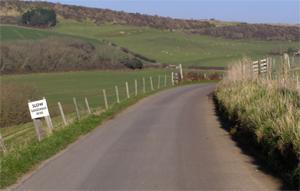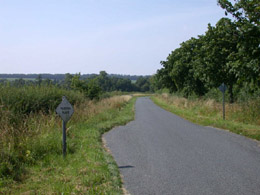Driving on Rural Roads
Statistics show rural roads can be the most dangerous roads to drive on. Around 66% of people killed on Britain’s roads are killed on rural roads. Motorways may seem more frightening, but statistics show they are far safer than the seemingly quieter roads of the countryside.
Speed
Most rural roads have a speed limit of 60 mph. However, this doesn’t mean you should always drive at this speed. As with all driving, you should drive at an appropriate speed for the road conditions. Many rural roads are narrow, twisting and can have poor surfaces.
Many inexperienced drivers take corners too fast, especially on rural roads where the severity of a bend can be hard to judge. You should always reduce your speed as you approach a bend. Remember, the bend may hide a horse and rider, a slow-moving vehicle or another hazard.
Blind Bends
Blind bends are commonplace on rural roads (see photo right) and have no view beyond the bend. This means they can hide on-coming traffic, pedestrians, horses and other hazards.
On A-roads, you will often find the road marking ‘slow’ will warn you of a blind bend ahead, but on more minor roads, such markings are rare.
Treat blind bends like any other hazard, slow down, check your mirrors and be prepared to stop.

Single-Track Roads
These are roads (not unique to rural areas) that are not wide enough for two vehicles to pass at once. To make matters worse, these roads are often lined with hedges and are full of twists and turns, which reduces the driver’s ability to see ahead. Even though many of these roads have the national speed limit of 60 mph, you should always drive at a speed you feel is safe and appropriate. Remember the golden rule of speed:
always drive at such a speed that you can stop comfortably in the distance ahead you can see to be safe.
When visibility is limited by hedges and bends, you can use your horn to warn other road users of your presence. At night you can flash your headlights to give a similar warning.
To allow two vehicles to pass each other, single-track roads have regular passing places (see photo above) which are basically road extensions bulging out to the side of the road. Some of these will be marked, but in my experience, most are not. Some will have a tarmac surface, but many will be more grass and earth than a road, and may even be difficult to recognise.
When approaching another vehicle, continue onwards until there is only one passing place left between you. The first vehicle to reach this passing place should stop and pull into it, allowing the other vehicle to pass.
If you drive through a bend and find your path blocked by a vehicle ahead, one of you will have to reverse into the nearest passing place. There are no exact rules to follow. However, if a passing place is close behind, be polite and reverse into it. If, however, you can see a passing place close behind the other vehicle, wait for them to move into it. Common sense is all it takes.

Animals
When approaching horses and other animals, you should reduce your speed and allow them plenty of room as you pass. Don’t rev your engine, sound your horn or do anything which may frighten them.
If you come across a flock of sheep or herd of cattle blocking your way, you must stop, switch off your engine and wait until they have left the road.
Farm Vehicles & Slow Moving-Traffic
The first rule is to be patient and not to feel pressured into having to overtake a slow-moving vehicle, even if a queue of traffic is building up behind you.
Keep well back so that you can see the road ahead clearly. Only overtake when it is safe and legal to do so. You may find that drivers behind you will try and overtake you and the slow-moving vehicle in one go, so keep an eye on your mirrors and always check them before pulling out to overtake.
Mud on the road may be a sign that a farm vehicle is close-by. Be aware that such a vehicle may emerge from a concealed field entrance.
At Night
Many rural roads don’t have street lighting, although most have cats-eyes, as seen in the image below. These highlight the lane you are travelling in, and show you the direction the road is taking.
Many single-track roads have no lighting and no cats eyes.

Key Signs

Accompanied horses or ponies

Bend to right (or left if symbol is reversed)

Cattle

Double bend first to left (symbol may be reversed)

Hump bridge

Uneven road

Ford (risk of flood water)

Wild animals
